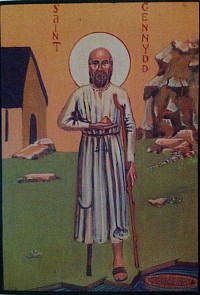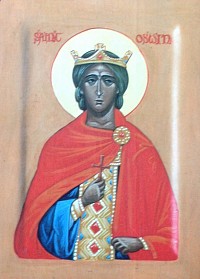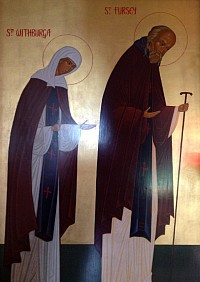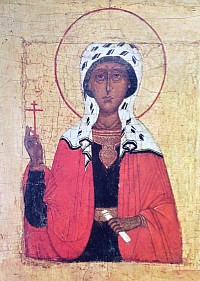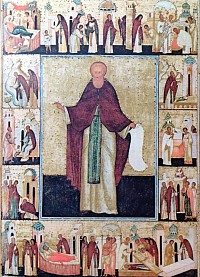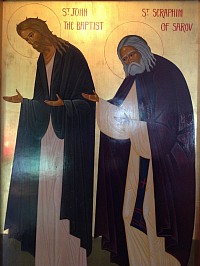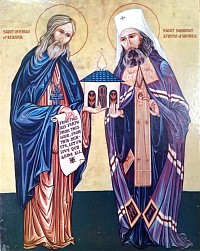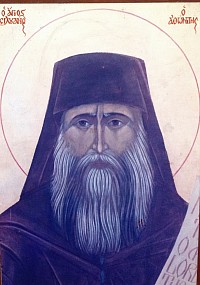Gallery
St Cenydd, (Kenneth)
Not to be confused with the saint of the same name who was Irish and popular in Scotland, Cenydd was a Christian hermit of the Gower Peninsula in Wales where place-name evidence indicates he was the founder of the church of Llangennyth. Stories about his origins are probably only legendary, recalling as they do the story of Moses in the basket. However, there are some elements of his story that are probably more reliable historically. It is fairly certain he was a cripple and a hermit. (It is said that after being cured by St David in 545, he returned to life as a hermit and prayed for his healing to be revoked.)
Cenydd's Feast Day is marked on 5 July. Up to the early twentieth century the festival was traditionally marked by the displaying of an effigy of a bird from a pole on the church tower, symbolising the legendary birds who cared for the infant Kenny, and the consumption of whitepot or 'milked meat' a dish made of flour, milk, sugar and dried fruits, not unlike a rice pudding or bread and butter pudding. It is thought he died on 27th June.
St Aidan of Lindisfarne
An Irishman, possibly born in Connacht, Aidan was a monk at the monastery on the Island of Iona in Scotland.
The Roman Empire had spread Christianity into Britain, but due to the Anglo-Saxon invasion of Britain, Anglo-Saxon paganism was, by the late fifth century, the dominant religion except in Wales and certain parts of Western England. The foundation of the monastery of Iona, in A.D.563, marked the beginning of an Irish mission in what is now Scotland, while in the south-east, the work of St.Augustine of Canterbury, beginning in 597, represented a missionary endeavour inaugurated in Rome by St.Gregory of the Dialogues (in the West usually known as St.Gregory the Great).
King Oswald of Northumbria requested missionaries from Iona, the pre-eminent monastery of the Irish in what is now Scotland, rather than the Roman-backed mission in the south. At first the monastery sent a new bishop named Cormán, but he met with no success and soon returned to Iona, reporting that the Northumbrians were too stubborn to be converted. Aidan criticised Cormán's methods and was sent as a replacement in 635.
Aidan chose Lindisfarne, an island like Iona and close to the royal fortress of Bamburgh, as his base. An inspired missionary, Aidan would walk from one village to another, politely conversing with the people he saw and slowly interesting them in Christianity. According to legend, the king gave Aidan a horse so that he would not have to walk, but Aidan gave the horse to a beggar. By patiently talking to the people on their own level, Aidan and his monks slowly brought Christianity to the Northumbrian communities.
Aidan died on 31 August 651, in the 17th year of his episcopate. He had become ill while at the Bamburgh castle and died leaning against the buttress of a church on a royal estate near Bamburgh.
The monastery he founded grew and helped found churches and other monasteries throughout the area. It also became a centre of learning and a storehouse of scholarly knowledge. Saint Bede the Venerable would later write Aidan's biography and describe the miracles attributed to him. In the nineteenth century, the Anglican Bishop Lightfoot, whose diocese included Lindisfarne, called Aidan "Apostle of the English", which is a title usually connected to St. Augustine of Canterbury or Pope St. Gregory the Great. Saint Aidan's feast day is on 31 August.
St Oswin
King and martyr, Oswin was murdered at Gilling, near Richmond, Yorkshire, England on 20 August, 651. He was the son of Osric, King of Deira in Britain. On the murder of his father by Cadwalla in 634, Oswin, still quite young, was carried away for safety into Wessex, but returned on the death of his kinsman St. Oswald, in 642, either because Oswy had bestowed upon him Deira, one portion of the Kingdom of Northumbria, himself ruling Bernicia, or, as is more probable, because the people of Deira chose him for king in preference to Oswy.
St Colman
Colmán of Lindisfarne (C. 605 – 18 February 675) was Bishop of Lindisfarne from 661 until 664. He succeeded Aidan and Finan. Colman resigned the Bishopric of Lindisfarne after the Synod of Whitby called by King Oswiu of Northumbria decided to calculate the date of Easter using the method used in most of the Christian world of the First Ecumenical Council, preferring instead the Irish system (spread in Britain from St.Columba's foundation of Iona) which reflected older and less accurate calculations. After his resignation he retired to live on the island of Inisbofin in Galway where he founded a monastery.
Saints Withburga and Fursey
As two 'local' saints these have a special place on our ikon screen and in our veneration. They are a strong reminder to us that the saints of Western Europe who lived before the mid-eleventh century are not just 'Western' saints but are saints of the universal Orthodox Church.
St Withburga was an East Anglian saint who lived in a hermitage very close to Walsingham, at Holkham, and who after her father's death in AD 653 used her inherited wealth to build a convent at East Dereham. After her death in AD 743 she was buried in the abbey grounds, and tradition has it that she was disinterred 55 years later and found to have avoided decomposition, so that these remains were removed into the church she had built.
In AD 974 Brithnoth, the abbot of Ely, seeing how pilgrims flocked and brought wealth to Dereham, plotted to steal her mortal remains to make Ely the centre of pilgrims seeking to visit her body. Brithnoth arrived with armed men and organised a feast. Having got the locals thoroughly inebriated he and those with him made for home with the body of Withburga. When the Dereham men sobered up, they discovered the theft and set off to recover her. They were however, unable to cross the swamps that surrounded Ely, and Withburga's relics remained until scattered at the time of the reformation.
When the Dereham men returned home, it is said that they found a spring of water to have developed in what had been her tomb. Taking the view that the water was compensation for the loss of their saint, they kept attracting pilgrims to drink from the water. This spring has allegedly "never run dry" and even today remains a tourist attraction.
St Fursey was an Irish monk, born the grandson of a pagan king (probably in practice a wealthy community leader rather than anything else more grand). His mother was a Christian and daughter of another "king", and he was baptised by Brendan (himself later canonised) who was his great uncle, and in whose monastery he went to live at an early age, in time building his own monastery. In time he had a series of visions before founding two more monasteries.
Meanwhile, here in East Anglia, King Sigeberht set about extending Christianity as the local religion. Fursey arrived with a few others, and after meeting Sigeberht were given enough land to establish an abbey. The land given to him was an abandoned Roman fort, probably in what we now call Burgh castle.
The approach of war in AD 648 encouraged Fursey to leave for the Britanny area of what we now call France, where he died in AD 650.
St Olga
Born in 890, accounts differ as to her origins, but it is believed she was a princess who lost her husband in battle. On his death she became the official ruler of Kievan Rus until her year old son became of age. A prince wanted her to marry him, but she wanted to hold onto power, and did so ruthlessly, with an inconvenient volume of bloodshed. She remained the Regent Ruler of Kievean Rus.
In 945 or 957 (accounts differ) she converted to Christianity, and the accounts of her reception in Constantinople are described in detail by Constantine III. After baptism she took the name Yelena after the reigning Empress Helena Lekapena.
Olga Yelena was the first Russian to be declared a saint following her efforts to convert her people. She failed to convert her son however, and it was left to her grandson Vladimir I to make Orthodox Christianity the state religion. She died in 969.
St Paraskeva of Iasi
Paraskeva of Iasi is also known as Parascheva of the Balkans, of Serbia, of Belgrade and the New. She was born around the beginning of the 11th Century and would, if she lived today, be seen as a teenage runaway.
A daughter to a wealthy high status Christian family living in Epivat (now in Turkey) by the Marmara coast, she was in church at the time she paid particular attention to the words “Whosoever will come after Me, let him deny himself and take up his cross, and follow me” and spent considerable hours thereafter reflecting on what they really meant. She began giving away the expensive clothes, her parents had given her, to poor people. Actions about which her parents weren't especially thrilled. They had worked hard for their lifestyle and couldn't afford for her to be giving it all up to strangers. All efforts to encourage her to desist and refrain fell on deaf ears. It would be easy to think that there were many arguments and raised voices over her decisions and in the end Paraskeva ran off to Constantinople and spent as much time as she could in prayer.
Her parents, meanwhile and quite reasonably, were even more upset about losing their (disobedient) daughter than they were about her giving away her possessions, and followed after her in 'hot pursuit' travelling from city to city trying to track her down. Paraskeva, reckoning she could only elude them for so long before they caught up with her, moved on to Chalcedon and then again to Heraclea Pontica near the Black Sea. There she lived an ascetic life and believed she saw visions, one of which instructed her to go to Jerusalem.
After some time in Jerusalem she joined a convent in the Jordanian desert before returning to Constantinople. By the time she was 25 she had moved to the village of Katikratia where she lived till she died at the age of 27. Years later a monk dug up remains he believed to be hers, and via the church in which she last lived these were moved to Tirnovo, in Bulgaria, then to Belgrade, in Serbia, and finally to Constantinople. In 1641, they were given as a gift to the Prince of Moldavia, Vasile Lupu, in recognition of his support for the Ecumenical Patriarchy of Constantinople. These remains have been in Iasi ever since. She is venerated as the Protector of Iasi and all of Moldavia, and in the Balkans her memory is a major festival each year on October 14th.
St Gregory Palamus
St Gregory had the good fortune to be born in Constantinople in 1296. He had the better fortune that after his father, a courtier of Emperor Andronikos II Palaiologos (1282 - 1328), died while he was yet an infant, that Andronikos decided to play a key role in his upbringing and education. In 1316, despite wishing that Gregory would devote his life to service in the government, Gregory took himself off to Athos to the Vatopedi monastery. In time Gregory moved to St Athanasius monastery on Athos where he became a waiter and sang in the choir. Time passed and Gregory sought a more aesetic life, so joined a Skete, which is a group of monks within a monastery setting themselves apart from the main brotherhood where he taught a discipline of prayer called Hesychasm.
Hesychasts practice a method of contemplative prayer of praying with their head between their knees in the manner of Elijah, which seeks to block out the physical senses focusing inwardly on God. This type of meditation is a strict interpretation of Matthew's gospel where Jesus is quoted as saying "go into your closet to pray". Hesychasts use the Jesus Prayer to "Guard the Mind" with a purpose to devote themselves so totally to God to the exclusion of absolutely everything else. This practice of Hesychasm has its roots in the Jewish mystical tradition of Merkabah, whose practitioners invoked the Divine Name (Hashem) while rhythmically breathing. Hesychams practitioners reciting the Jesus Prayer instead of Hashem.
Turkish invaders were a real threat at this time in the world history, and in 1326 Gregory and some others sought refuge in Thessaloniki, where he was ordained priest. Trying to balance his own spiritual needs with serving the spiritual needs of his parishioners, he founded a community of hermits in Veria. Later he was made Abbot of the Esphigmenou monastery, but the monks rejected his aescetic style and in 1335 he was forced to resign.
After this Gregory concentrated on writing and opposing heresy. Principal of heresies Gregory opposed was led by Barlaam, whose influence grew such that the dispute surrounding Hesychasm was brought before an Ecumenical Council in May 1341 in Constantinople. Barlaam was denounced as a heretic and Barlaam left for Calabria to join the Roman church.
Three years later Gregory fell foul of Patriarch John XIV , who had him imprisoned till Patriarch Isadore was enthroned whereupon he was released and consecrated Metropolitan of Thessaloniki. Unfortunately he was not popular with his people and he didn't actually occupy the episcopal chair till 1350. Four years later, on a ship travelling to Constantinople, he was captured by Turks who imprisoned and beat him. They took him to the Ottoman court where he was treated well till his ransom was paid. Gregory returned to Thessaloniki as Archbishop where he lived for the last three years of his life. Gregory died November 14th 1359.
St Sergius of Radonezh
One of the most significant of the canon of Russian Orthodox Saints, Sergius was a spiritual leader and reformer of medieval Russia. He was born sometime between 1314 and 1322 with the name Bartholomew to parents Kirill and Maria. To escape poverty they moved with him to Radonezh with his two brothers. He was illiterate till a spiritual elder (staretz) gave him some prosphera (a special bread used in the Holy Liturgy-see elsewhere) at which point he became able to read and write. (This may not be the whole story). After his parents death he went to Khotkovo where his brother Stefan was a monk. Together they moved to a forest and built a church. In time Stefan moved to a Moscow monastery and Bartholomew took the name Sergius and lived as a hermit.
Somehow he attracted the company of other monks, and eventually he was elevated to the senior position and ordained priest of what had itself become a monastery. He eventually became the inspiration of 40 monasteries. He died on September 25th 1392 and was canonised in 1452.
Saints John Baptist and Seraphim of Sarov
Ikons are 'windows into eternity' and so it is quite proper for two saints who lived almost two millennia apart to be represented together. St. John the Baptist really is too well known to need further description, besides he has already been described elsewhere in this gallery, so let us turn our attention to Seraphim.
Seraphim was born Prokhor Moshnin July 19th 1754, in Kursk. As a ten year old he fell ill, had a vision of Mary, the Mother of God, telling him he would recover. Several days later a religious procession passed his house carrying a special ikon of Mary. Upon standing to watch it he made a rapid recovery. During the rest of his childhood he developed an interest in Christianity and found a liking in withdrawing from the family to pray. At 18 he entered the Sarov monastery.
He took the ascetic aspect of the monk's life with great seriousness, eating as little as would keep him alive. Taking to a forest to pray and live as a hermit, he again became seriously ill, needing three years to recover. He recorded that he again saw a vision of Mary and again she promised he would recover.
He took full vows in 1726, at the age of 27, taking the name Seraphim. After being ordained Deacon and then Priest, he withdrew again, in 1794, to the forest. After a savage beating by thieves, who stole very little as he had very little to steal, he pleaded for mercy when they were eventually caught and brought to justice. The beating, however, was so brutal he spent the rest of his life hunched, needing a stick to help him walk.
His evident holiness drew thousands of people to him. He died 14th January 1833, and remains one of the most important and most loved saints of Russia.
Saints Herman and Innocent
St Herman of Alaska was born between 1756 and 1760 in Russia. As a 16 year old he began life as a monk and varied his time there between living in the monastery and living as a hermit. In 1793 he was one of a party of eight who were chosen by the monastery to travel to the Aleutian islands of Alaska and make Christians of the natives there. After a series of fateful disasters, only Herman was left, and so he took refuge on Spruce Island naming it New Valaam (after the monastery he left behind). He dug a cave in which he lived till he could build a proper cell, and lived off the land. He lived the ascetic life of hardship and avoided comforts and luxuries wherever possible. He stood up for the rights of the natives, what we know as the Red Indians, helping them out practically, defending them against those who would take advantage of them. An enormously articulate man, he helped many to find the Orthodox faith and became loved amongst those with whom he lived. Various miracles are attributed to him during his life, one in particular involved preventing fire, and another preventing flood. He died on December 13th 1837.
St. Innocent was born John on August 26th 1797 in Russia. In 1807, he entered the Irkutsk Theological Seminary, and 10 years later he married. In 1817 he was ordained deacon of the Church of the Annunciation in Irkutsk, finishing his studies in 1818. He was appointed a teacher in a parish school, and in 1821 he was ordained priest to serve in the Church of the Annunciation. At the beginning of 1823, Bishop Michael of Irkutsk received instructions to send a priest to the Aleutian Islands of Alaska. Father John Veniaminov volunteered to go, and on May 7th 1823, he departed from Irkutsk, accompanied by his family. They arrived at Unalaska on July 29th 1824, overlapping Herman by 13 years.
John and his family settled well into their new life, and John, who was a natural linguist, set about learning the languages and dialects of the area, intent upon communicating Christianity to the natives. He travelled widely, even as far south as northern California, building churches where he could. In 1834, John was transferred to Sitka Island, to the town of Novoarkhangelsk, later called Sitka, continuing his linguistic studies and converting the locals.
In 1838, while on a journey to Moscow to seek permission to expand his work, he learned of the death of his wife. Taking monastic vows two years later, he chose the name Innocent. On December 15th 1840 he was consecrated Bishop of the diocese he created in Alaska, becoming Archbishop in 1850, and was appointed Metropolitan of Moscow in 1867. He died March 31st 1879.
St Silouan the Athonite
Born Simeon Ivanovich Antonov in 1866, he holds a rare position that he was caught by photography and his image is available. Thus ikonic representations of him are fairly consistent. An ascetic he spent much of his life in prayer, he was seen by his contemporaries to be an elder. Thomas Merton described him as the "most authentic monk of the 20th Century". One of his more memorable sayings was "Those who dislike and reject their fellow-man are impoverished in their being. They do not know the true God, who is all-embracing love".
He died on September 24th 1938.
New Martyr St Elizabeth
One of Queen Victoria's daughters was Princess Alice. She married Grand Duke Louis IV of Hesse and their second daughter was named Elizabeth. They also had another daughter, Alexandra Fyodorovna, and she was the last empress of Russia.
Diptheria has been largely eradicated now, but it was a highly contagious disease in 1878, spread by physical contact or inhaling the secretions of those already infected, and it infected much of the royal household killing not only one of Elizabeths' sisters, but her mother Princess Alice, also. Fortunately Elizabeth was away and avoided the disease, but orphaned at 14 she was brought up partly by Queen Victoria but remained in contact with her remaining family in Russia, the Tsar Nikolas, Tsaritsa Alexandra and Grand Duchess Elizabeth. Eventually she married Grand Duke Sergei of Russia in 1884, and together they adopted the orphaned Grand Duke Dmitri Pavlovich and his sister Grand Duchess Maria Pavlovna.
Elizabeth converted to Orthodoxy from Protestantism in 1891, and 14 years later she was widowed by a Communist bomb which assassinated her husband. She herself heard the bomb and she herself helped collect the scattered body parts from whence they had been blasted.
She decided to become a nun, and she sold and gave away her wealth and possessions and spent her remaining life working in Moscow in the refuge she had built to aid orphans and the poor. On July 18th 1918 Elizabeth, along with various others, were herded deep into a forest by the Bolsheviks, pushed into an abandoned mineshaft and were blown up by the grenades they threw in. In 1992 she was declared a saint.
St George
A Greek who became an officer in the Roman army, George's father was Gerondios from Cappadoccia Asia Minor, and his mother was Polychronia from the city Lyda. (Lyda was a Greek city from the times of the conquest of Alexander the Great in 333 BC, and is now in Israel.) George became an officer in the Roman army in the Guard of Diocletian in and around Nicomedia, in modern Turkey. He is venerated as a Christian martyr, having allegedly been tortured and decapitated in the early 4C Christian purges. In hagiography (the word Orthodoxy uses to describe the biography of saints) George is immortalised in the tale of St George and the dragon and his feast is celebrated on 23 April.
